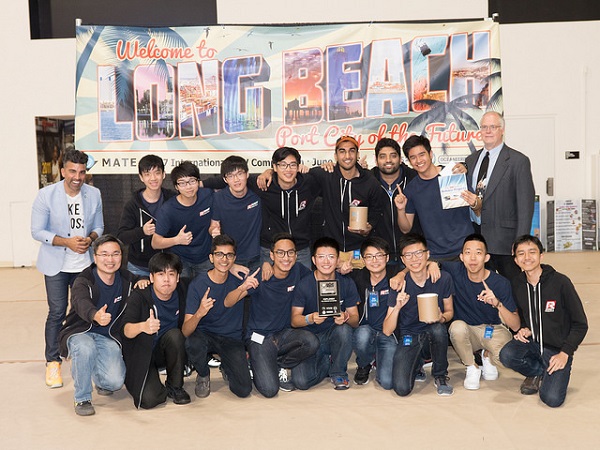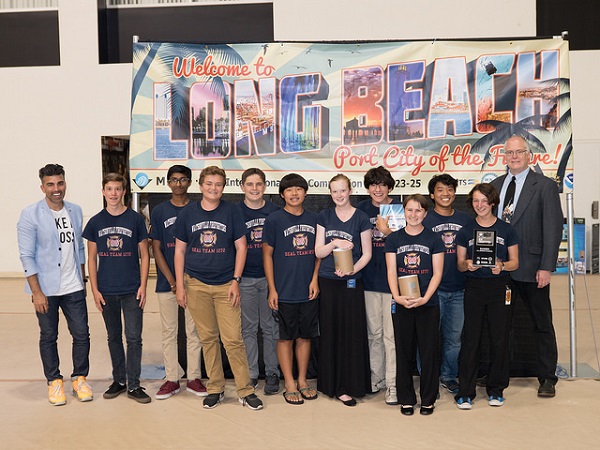
(Photo courtesy of Marine Advanced Technology Education Center, and used with permission.)
Jill Zande uses underwater robots to fire students’ imagination.
Podcast: Play in new window | Download
Subscribe: RSS
As Associate Director of the Marine Advanced Technology Education (MATE) Center, in Monterey, Jill is the founder of MATE’s annual student ROV (remote-operated vehicle) competition. Since its creation in 2002, the MATE Center’s underwater robotics competition has grown to an international event, in which 710 teams participated in 2017.
And the goal: to get students involved in problem-solving, using science, technology, engineering, and math skills. Art comes into the mix, as well: students must give presentations on their robot, produce marketing materials and raise funds, in addition to building the robot itself. And, of course, robots have to be able to perform a specific series of tasks, as set out by that year’s contest guidelines.

The Hong Kong University of Science team, top winners in MATE Center’s Advanced (Explorer) class of the 2017 International ROV Competition (Photo courtesy of Connor Gallagher and Patrick Webster, and used with permission.)
Teams from around the country, and around the world, start building their robots at the start of the school year. The competition includes divisions for students from kindergarten, right up to through college age. Regional underwater ROV competions start in the spring, with the winners advancing to the International ROV Competition in June.
In addition, MATE has thirty regional robotic workshops, across the world, for parents, students and teachers.
Jill talked about her background, getting to develop the MATE Center from just after it received start-up funding from the National Science Foundation, and how the underwater robotics competition began and has grown since its inception in 2002. (And, she gave a preview of the MATE Center’s new nonprofit: MATE Inspiration for Innovation!

Watsonville Firefighters SEAL Team 1272 won first place in their Ranger (intermediate) class at MATE Center’s 2017 International ROV Competition. (Photo courtesy of Connor Gallagher and Patrick Webster, and used with permission.)
On this edition of Over Coffee® you’ll hear:
-
How Jill first became interested in marine biology and underwater robotics;
-
How she came on board with the MATE Center shortly after its start in the late 1990s, and grew with the organization;
-
The story of MATE Center’s international ROV Competition;
-
The skills students learn, in the arts and communication areas, while working on their robots;
-
How the competition can lead students to connections for their future careers;
-
Some of the engineering challenges around which students need to work, in creating and piloting their robots for the competition;
-
When MATE Center is releasing its briefing for its 2018 International ROV Competition (hint: it’s happening really soon from this publication date!)
-
How the rounds of regional competitions work, around the world, leading to the Grand Championship in June;
-
The opportunities MATE Center offers to education professionals (year-round!);
-
How teams can work with their robots beyond the competition;
-
How MATE Center’s International ROV Competition has grown and evolved, since its inception in 2002;
-
An innovation which MATE Center developed, to help students, parents and schools get around a roadblock to competing;
-
Some of the most clever ways students applied their creativity to problem-solving;
-
What 2017 International ROV Competition teams experienced, in terms of tasks during the event;
-
The dates and place for next year’s MATE Center International ROV Competition (and a couple of hints about next year’s theme!)
-
The mistakes teams will want to avoid, in creating their robots;
-
What Jill herself learned, as an educational professional, from the MATE Center’s International ROV Competition.
-
And, a preview of MATE Center’s new nonprofit organization!

Love the background on Jill’s computer! STREAMWORKS!
Dennis, we really ought to do an interview sometime about what STREAMWORKS does, if you have the time.